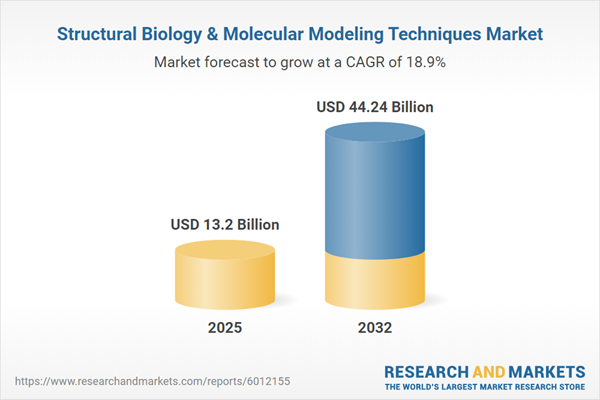Speak directly to the analyst to clarify any post sales queries you may have.
The Structural Biology & Molecular Modeling Techniques Market is evolving rapidly, driven by the integration of advanced experimental and computational technologies. This progression is reshaping research across biopharmaceutical, academic, and clinical domains, offering organizations new avenues for innovation and operational efficiency.
Market Snapshot: Growth and Opportunity
The structural biology and molecular modeling techniques market grew from USD 11.10 billion in 2024 to USD 13.20 billion in 2025. Strong compound annual growth is expected to continue, with projections indicating a market value of USD 44.24 billion by 2032 and a robust CAGR of 18.86%. Rising demand for detailed macromolecular visualization, heightened investment in automation, and the adoption of machine learning in research workflows are key market drivers.
Scope & Segmentation
This report delivers in-depth analysis and forecasts across core segments and geographies, providing a strategic lens for senior decision-makers. The following market segmentations are covered:
- Techniques: Computational Modeling (including ab initio modeling, homology modeling, molecular dynamics), Cryo-EM (single particle analysis, tomography), Mass Spectrometry (ESI, MALDI-TOF), NMR Spectroscopy (solid state, solution), X-ray Crystallography (powder, single-crystal).
- Product Types: Instruments, Reagents and Consumables (such as enzymes and kits), Services, Software.
- Applications: Biomarker Discovery, Drug Discovery (lead identification, lead optimization), Protein Engineering, Structure Function Analysis.
- End Users: Academic Research Institutes, Biotechnology Companies, Contract Research Organizations, Pharmaceutical Companies.
- Workflow Steps: Data Collection (automated, manual), Data Processing, Sample Preparation, Visualization.
- Regions: Americas (covering North America and Latin America), Europe, Middle East & Africa (including Western Europe, emerging Middle Eastern and African research hubs), Asia-Pacific (spanning China, India, Japan, Australia, South Korea, Indonesia, Thailand, Malaysia, Singapore, Taiwan).
- Key Companies: Thermo Fisher Scientific Inc., Danaher Corporation, Agilent Technologies, PerkinElmer, Shimadzu Corporation, Bio-Rad Laboratories, Bruker Corporation, Waters Corporation, Dassault Systèmes SE, Schrödinger Inc.
Key Takeaways
- Integration of machine learning and artificial intelligence is enabling more precise molecular modeling, reducing dependence on experimental data and optimizing candidate screening workflows.
- Advancements in cryo-electron microscopy and mass spectrometry support high-throughput analyses and drive quality improvements in structure elucidation workflows.
- Interdisciplinary collaboration—linking biologists, chemists, informaticians, and clinicians—supports faster hypothesis testing and translation of insights into therapeutic applications.
- Open science initiatives and data sharing frameworks are accelerating reproducibility and driving global knowledge exchange across research communities.
- Industry competitors are expanding portfolios through targeted acquisitions, partnerships with academic consortia, and development of modular, scalable solutions tailored to emerging workflow needs.
Tariff Impact on Supply Chain Resilience
Recent United States tariffs on imported scientific equipment, reagents, and software have introduced procurement complexities for many organizations. Elevated costs and extended lead times have prompted a shift toward alternative sourcing, strategic stockpiling, and the cultivation of domestic supplier relationships. These measures support operational continuity while navigating increased administrative and regulatory barriers. Cross-border collaborations may also face increased oversight, requiring agile response frameworks and proactive risk management across international teams.
Methodology & Data Sources
The insights presented in this report are derived from extensive secondary research, structured expert interviews, and direct surveys with industry leaders and laboratories. Data triangulation validated findings, while peer review by subject-matter experts ensured rigorous quality control.
Why This Report Matters
- Enables executive teams to develop targeted R&D and procurement strategies aligned with technology trends and regulatory environments.
- Provides actionable insights for optimizing supply chains and leveraging regional advantages in a shifting trade landscape.
- Empowers stakeholders to anticipate disruptive market changes, ensuring informed capital allocation and sustainable business growth.
Conclusion
Strategic adoption of technological innovations, robust supply chain management, and collaborative partnerships will define success in the structural biology and molecular modeling sector. Organizations equipped with actionable intelligence from this report are positioned to unlock value and remain adaptive in a dynamic market.
Additional Product Information:
- Purchase of this report includes 1 year online access with quarterly updates.
- This report can be updated on request. Please contact our Customer Experience team using the Ask a Question widget on our website.
Table of Contents
3. Executive Summary
4. Market Overview
7. Cumulative Impact of Artificial Intelligence 2025
Companies Mentioned
The companies profiled in this Structural Biology & Molecular Modeling Techniques market report include:- Thermo Fisher Scientific Inc.
- Danaher Corporation
- Agilent Technologies, Inc.
- PerkinElmer, Inc.
- Shimadzu Corporation
- Bio-Rad Laboratories, Inc.
- Bruker Corporation
- Waters Corporation
- Dassault Systèmes SE
- Schrödinger, Inc.
Table Information
| Report Attribute | Details |
|---|---|
| No. of Pages | 199 |
| Published | October 2025 |
| Forecast Period | 2025 - 2032 |
| Estimated Market Value ( USD | $ 13.2 Billion |
| Forecasted Market Value ( USD | $ 44.24 Billion |
| Compound Annual Growth Rate | 18.8% |
| Regions Covered | Global |
| No. of Companies Mentioned | 10 |









